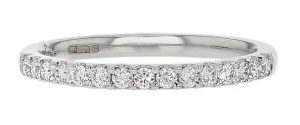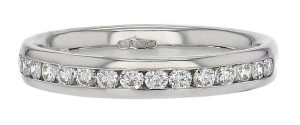Should I have diamonds in my wedding band or not?
It’s always best to consider whether you wish to add an eternity ring to your engagement and wedding set in the future. Only you can decide how much sparkle is the right amount for you. Solitaires or cluster engagement rings can suit a range of diamond set wedding bands. With shoulder set engagement rings you either choose the contrast of a plain polished wedding band or match the setting style in the engagement band with the wedding ring.
There are lots of setting options that will contrast with and compliment your engagement ring. Understanding the differences in styles can help you decide.







